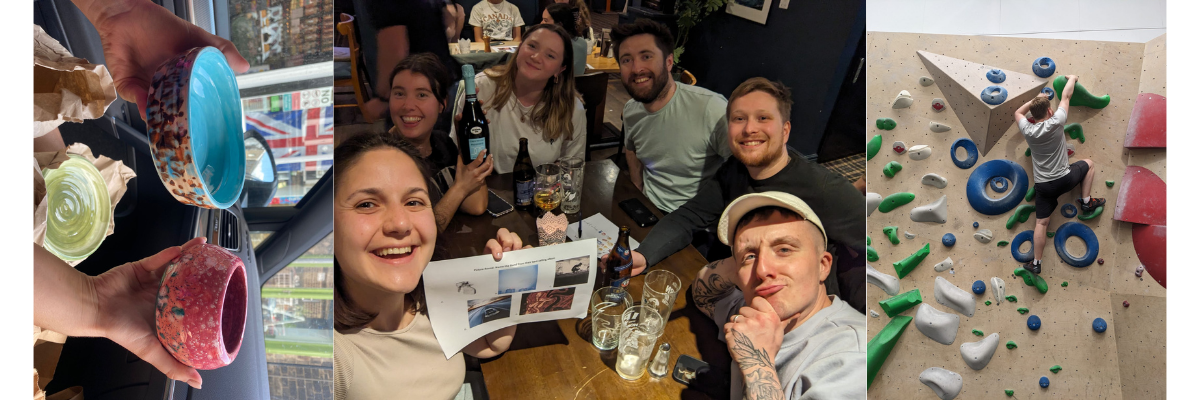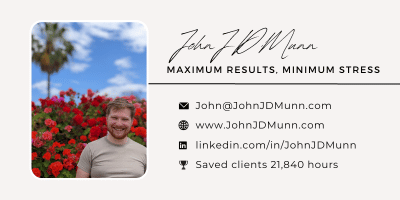🎯 Work Smart Wednesday - June 18, 2025
Who your most important client is, subtraction vs addition, and a quote on decisions
Work Smart Wednesday
👋 Hey there!
Here is your fortnightly dose of Work Smart Wednesday.
In these emails I will share with you 3 things to help you work smarter.
💡 Did you know you can find additional insights from me on my LinkedIn profile?
1. 🥇 Who your most important client is
Would you trust a dentist with bad teeth?
A financial advisor who is completely broke?
A personal trainer who is severely overweight?
Probably not, I know I wouldn’t.
However, I see examples like this all the time. Web designers with bad websites, social media marketing agencies with poor social media profiles of their own, course creation coaches who sell 1:1 calls rather than courses, sales consultants who put most people off with a hard sell, stressed yoga teachers, and cleaning companies with filthy vans. I could go on. These ironies erode a customer’s trust in you, and they kill your business.
The cause for all of these cognitive dissonance driving credibility killers is the same: you spend so much time and energy focused on delivering for customers that you forget an important truth - you are your most important client.
Make sure clients can see that you have done the work for yourself first. That your work rocks. That they can trust you.
Your business can survive without one client, but it cannot survive without one you. You won’t ever be able to charge proper prices or grow if you don’t look after your own business first. Invest in yourself.
Fix your own funnel first. Get your own life together. It will make everything else easier.

2. ✂️ Subtraction vs addition
If you were told to make the roof of the LEGO structure pictured below more stable, how would you do it? You have access to more LEGO.
Stop, look, and answer before reading on to reveal a special personal insight.
Did you add, move, or remove bricks to solve the problem?
When faced with a problem the vast majority of people look to add something to solve it, rather than remove the thing causing the problem (according to this study published in Nature, as well as my own observational experience). You probably have this bias yourself.
People have a bias towards addition, and that is very bad for your business.
Every time you add something, you multiply complexity. Because you, and all people, have a bias toward addition it makes it almost certain that you will naturally and unnecessarily increase complexity.
Unnecessary addition is the leading cause for burnout that I see among entrepreneurs who come to me for help - they have repeatedly added more, rather than taken away, to improve their business and life.
It is vital that we first consider subtraction when we think about growth and improvement. Simple solutions win. Helping people consider subtraction first is the basis of my favourite year end exercise, and my process for improvement (ESAD).
When faced with a problem, practice defaulting to the question “what could I remove or stop doing to solve this issue?”. The most successful people do less, but better.
P.s. some of my favourite “subtraction is the solution” businesses:
Putting holes in bricks helps them to be better insulators, lighter, and less expensive. Subtracting mass added value.
Contrary to common sense, removing highways often improves traffic, as happened with the Embarcadero Highway in San Francisco.
Balance bikes tackled the problem of kids learning to ride bikes not by adding stabilisers, but by removing the pedals and chain. This created a product category now worth $1.35bn (Billion, with a B 🤯).
P.p.s How to know what parts to take away in your business? This is where a funnel flow map comes into place. Being able to clearly see the flow between stages in your business helps you to identify how everything fits together and which things to focus on.
I talked about my funnel flow mapping sessions last week, but for those of you who missed it here is some key info:
😊 A 1:1 session to completely outline your funnel from start to finish and to show you how to easily take leads from strangers to sales.
🗺️ You will receive a custom funnel diagram of your business flow, as well as guidance on how to properly understand and use the diagram. Keep it forever.
💸 Expert advice on which parts of your funnel to focus on and how to fix your flow for optimal sales. Know exactly what to focus on next to grow your sales.
We will identify where your leads come from, how to easily qualify your leads, what you need to do (and in what order) to make your leads buy without objections, what to do once they buy, and how to maximise leverage to get the most out of every customer.
You can buy my Funnel Flow Mapping Sprint sprint here, with a £200 (!) saving if you buy it before the end of June using the code FLOWSTATE. Save £200 by buying now.
I do have limited availability for these sessions, once they’re gone they’re gone and I won’t be running this offer again this year. Sort your business out in a single session.
Session clip: How outlining a funnel together is useful (2 mins video)
3. 💡 Quote I'm pondering
“No decision is, in itself, a decision.” - William James
People often avoid making hard decisions by defaulting into making no decision at all.
Not deciding feels like a relief from responsibility. But ultimately, you will always remain responsible, you just choose to neglect your duty.
Unfortunately, opting to not decide is often the worst decision possible. You get:
all of the negatives of both options - you feel like you’re missing out by not taking action, and you simultaneously feel like you’re stuck. You feel bad for indecision.
and none of the benefits - you don’t get the relief of deciding to stay where you are, or the excitement or sense of progress that comes with taking action.
Not deciding is a decision for the status quo, for things to remain stuck as they are, but with the added negative that you also feel bad about it because you neglected your responsibility to decide.
Take control of your destiny, make the decision one way or the other.

👋 Want to work together?
When you're ready, here's the best way to get my help:
🔍 Clarity Call - We will discuss your business and create a step-by-step action plan together so you know exactly what you need to do next for maximum impact.
🆕 What I did instead
When people learn that I run a successful business but only work around 12 hours per week, their first question is almost always “what do you do with all your time?!”.
Below the surface of that question is fear: they are really asking whether life would be empty without constant work and overwhelm.
Society makes us feel like work is central to life, but it doesn’t have to be. You can choose to be a complete person without your core identity revolving solely around work. You can fill your life with whatever kind of joy you choose. You need to be able to see how everything fits together so you can choose what to focus on.
Here are some photos of things I have done in the past two weeks with my free time, the things I chose to do instead of working more.

What would you like to do more of if you had more time?
That's it! I can't wait to hear what you think. What did you find most useful? What do you want more or less of? Reply to this email now and let me know.
Also, if you have anything interesting to share, I want to know about it😊
Have a great week,
John
P.S. Did someone forward this to you? Subscribe here
P.P.S. Thank you for trusting me with your time. If these emails ever turn into a burden, I encourage you to unsubscribe. I want you to make the most of your time.
Enjoyed this issue of Work Smart Wednesday?
Refer a friend to sign up and earn valuable rewards









FYI, the "correct" solution to the LEGO problem is to remove the block in the back corner. No need to add or move anything, the roof doesn't need to be higher.